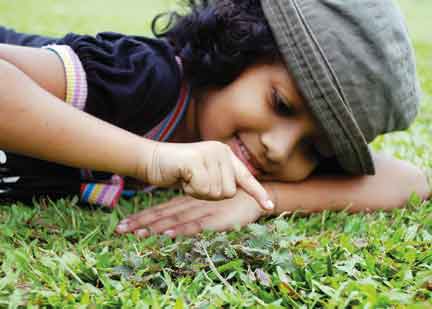Indumathi S
The Nature education division of the Salim Ali Centre for Ornithology and Natural History (SACON) conducted a study among students of class 6 to 10 in urban and semi-urban schools in Coimbatore. This study was conducted in order to find out how well the students are aware of their natural surroundings. The students were asked to name four yellow flowers that came to their minds. Eighty percent of the students named daffodil as the first flower that came to their minds followed by the yellow hibiscus and the yellow rose. These answers were stark, in the sense that the daffodil is not a flower that these students would have observed or even seen. But of course they had read about it in the poem, ‘Daffodils’, by William Wordsworth. We then started listing the common yellow flowers, which one could see in one’s surroundings. We came up with konnai (Cassia fistula), avarampoo (Cassia auriculata), plumeria, samandhi (Chrysanthemum), sunflower, etc. The flowers of vegetables like cucumber, pumpkin, tomato, lady’s finger, green chilli, etc., are all yellow. Hence, the above answers of students reveal how much they observe.
 The question to ask is, are we losing the natural instinct to observe or rather use our senses? Is this something to do with our education system or rather our textbook culture as Krishnakumar (former chairperson, NCERT) says? Krishnakumar1 in his Origins of India’s “Textbook Culture” points out how the curriculum was alienated during the time of colonial rule and “any specific or locally relevant knowledge of social affairs, politics or even one’s own life and surrounding was debarred”. This was further strengthened by textbooks. According to him2,
The question to ask is, are we losing the natural instinct to observe or rather use our senses? Is this something to do with our education system or rather our textbook culture as Krishnakumar (former chairperson, NCERT) says? Krishnakumar1 in his Origins of India’s “Textbook Culture” points out how the curriculum was alienated during the time of colonial rule and “any specific or locally relevant knowledge of social affairs, politics or even one’s own life and surrounding was debarred”. This was further strengthened by textbooks. According to him2,
The textbook written for teaching of English use literary pieces whose idiom and phrases were mostly steeped either in the domestic world of the Victorian bourgeois, or in its counterpoint – the natural world of Wordsworth and his early contemporaries. Neither of the two worlds was accessible to the Indian student. Poems about English spring or winter were as unrelated and strange to the Indian climate.
It is sad that the same textbook culture exists even today. Our whole system of education is geared towards exams, which only recognize textbook knowledge. Therefore, teachers and students tend to stick to the textbooks.
Is there a way out? At this juncture, is it possible to move away from the textbook culture? NCF 2005 has suggested that the curriculum be contextualized and local knowledge be recognized. NCERT textbooks have followed this suggestion. Their textbooks give a lot of scope for observation, survey, prediction, understanding of local context, etc.
Though not simple, there are ways to hone observation skills. When we got the results of the above study, we made an attempt to get children to develop their observational skills. We asked students to observe birds in their school as a first step. One school came with the concern that they had only one tree in their school and so far they had only seen crows and mynas. They were sure that they would not see anything more. But we suggested that they maintain a bird register in their school and observe the tree with patience for longer periods. A group of boys started watching birds and after a year of observation shared that they were able to observe 60 species of birds visiting their only tree. They also made other observations like when the tree blooms, when the leaves fall, when it produces fruit, how birds preen, clean, call, and so on. They realized by not caring to observe all these years, how much they had missed. They shared their observations and later went ahead to do research for a students’ science congress. Slowly, over the years, our nature education program had 100 schools networking with us and doing such small observations on various topics. They took up studies to identify butterflies, their feeding plants, etc. The teachers also found ways to encourage this kind of knowledge gathering, which had nothing to do with textbooks or examinations.
 What is possible?
What is possible?
To start with, teachers can encourage observation based on the lessons in the textbooks. Then small assignments, which involve at least week-long observations, can be included like observing clouds, flowering of plants, ant colonies, beehives, kinds of vehicles on the road, road signs on the way to school, spices in the food and so on. There should be space for sharing the observations made. The students can be asked to present their observation in the form of drawing, writing, or through charts. The teacher will have to budget time for such activities in his/her lesson plans. Science exhibitions or fairs, which involve observation, survey, etc., should be encouraged. Such studies always kindle curiosity and questioning. The students can also present their small observation studies in the school assembly or on the notice boards. Other forums for presentation like the school website, writing a small article for the local newspaper about their study, creating a school newsletter with the children’s work can also be explored. Recognition of students’ work motivates them and in turn helps build their confidence.
_____________________________________________________________________________
References
- Kumar. K, Origins of India’s “Textbook Culture”, What is worth teaching? New Delhi: Orient Blackswan, p 23-41.
- Ibid, p 33.
The author works with the academics and pedagogy team at the Azim Premji Foundation, Bangalore. She can be reached at mailindusow@gmail.com.
